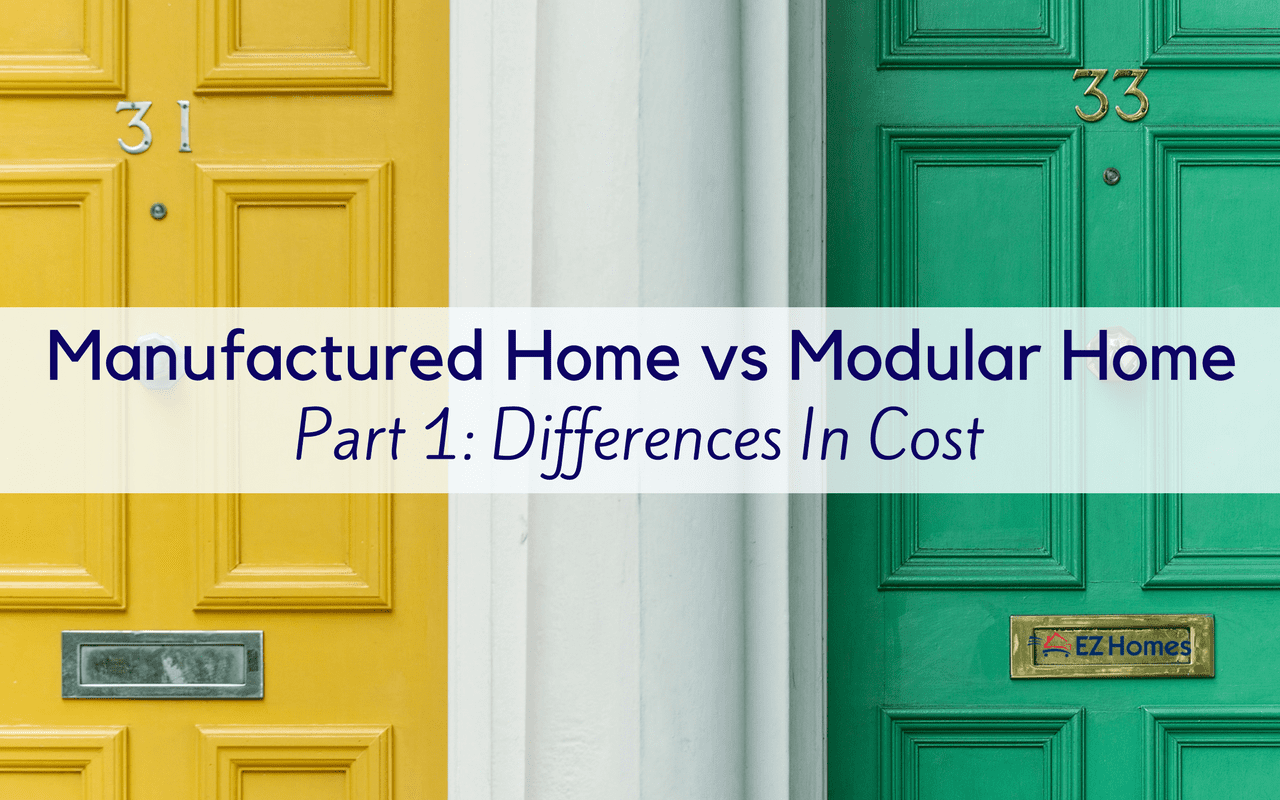If you’re new to either of these types of alternative housing, you might be a little confused as to the actual difference between a manufactured home vs modular home. After all, on the surface, they sound pretty similar…

They are both manufactured in a factory. They are assembled on location rather than built from scratch. And they are priced lower than traditional stick-built homes. However, there are important differences between the two that could have a dramatic impact on your experience and your plans for the future.
As such, it’s important that you know the big differences between these two types of housing as well as the smaller nuances. We’ll cover these differences in three parts: cost, physical characteristics, and lifestyle.
First of all, let’s quickly go over the naming conventions for each.
Modular homes
Modular homes also go by the names “factory-built” or prefabricated houses. As the names accurately imply, these homes come from a factory as opposed to traditional construction methods. This leads to quicker building times and cheaper execution than stick-built homes. “Modular home” is an equally accurate description as the manufacturer usually takes the home in separate “sections” and assembles it on-site.

They are becoming an increasingly popular alternative that is both less expensive yet retains the same curb appeal.
Mobile (ahem, Manufactured) homes
Also known by their outdated alias, “mobile home,” these homes are drastically different from the trailer homes of the 1970’s and earlier that carried this name. Now, they are formally known as “manufactured homes.”
This term came with the adoption of the HUD Code in 1976. The goal was to try and erase the bad reputation mobile homes had prior to this federal intervention. There was also a push to rebrand the industry with a more fitting name.
Since then, “mobile homes” have remarkable differences in quality of building materials, construction processes, and overall safety and standards. As a type of affordable housing, they provide many Americans with something akin to a family home at a bargain price, especially in the current housing crisis.
Costs of a manufactured home vs modular
Price
Just like stick-built homes, you’ll need to calculate the price of modular homes by cost per square foot. Take care when shopping around, it’s up to individual sellers how they label their prices. Some prices only include the base cost per square foot but don’t include any of the construction costs, taxes, etc. The “finished price” will include all of this. This article by Modular Homeowners explains it in a digestible manner.
Typically, modular homes cost around $200 per finished square foot. However, it depends drastically on the specific model. They can be just as expensive as stick-built homes but rarely go as low as manufactured homes.
Manufactured homes are one of the most affordable types of housing you can find. The rent for a home plus the lot rent typically comes to less (and often half) of that of an apartment. Prices depend heavily on whether you go for a smaller single-wide, double-wide or triple-wide.
An average double-wide, which is the most popular choice, goes for around $74,000-$90,000 for a new model. However, you can find secondhand or older models for less than $10,000.
Value over time
Another important price-related consideration to make when purchasing a home is how it holds its value over time. You probably want a property that appreciates as you can sell it for a higher price in the future.
Modular homes are as close to stick-built homes as you can get. They typically follow the same styles, have the same lifespan, and fall in the same market as stick-built homes. As a result, they appreciate in value over time.
Manufactured homes are seen more as personal property (or chattel). That means that they start to depreciate as soon as they are sold just like a car would. The average depreciation of value for a manufactured home is around 3%. However, this also means you can get older models for very cheap but in good condition.
Financing

Since modular homes are real estate, they qualify for traditional financing. However, modular home loans do work slightly differently. Banks will offer a two-stage loan. The first stage, called a construction loan, is when you pay off the interest and is in play until the home is complete. In the second stage, it then becomes a traditional mortgage. This is called a “construction-to-permanent” loan.
With manufactured homes, things aren’t quite as smooth. Because they are personal property, they won’t qualify for traditional financing as is. To be able to apply for traditional financing, the home will need to be permanently affixed to the property, made immobile, adhere to all HUD Safety Standards, and certified as real estate.
If you don’t meet all these requirements, you may still be able to qualify for an FHA backed loan, a VA loan or a chattel loan. However, for the first two, your home will need to adhere to the HUD code.
To be continued…
Come back by on Monday! In the next part of our manufactured home vs modular home matchup, we’ll be taking a look at their physical attributes including lifespan, appearance, size, and construction. By the end of our mini-series, you should have a comprehensive idea of the differences between the two and which one works best for you!


